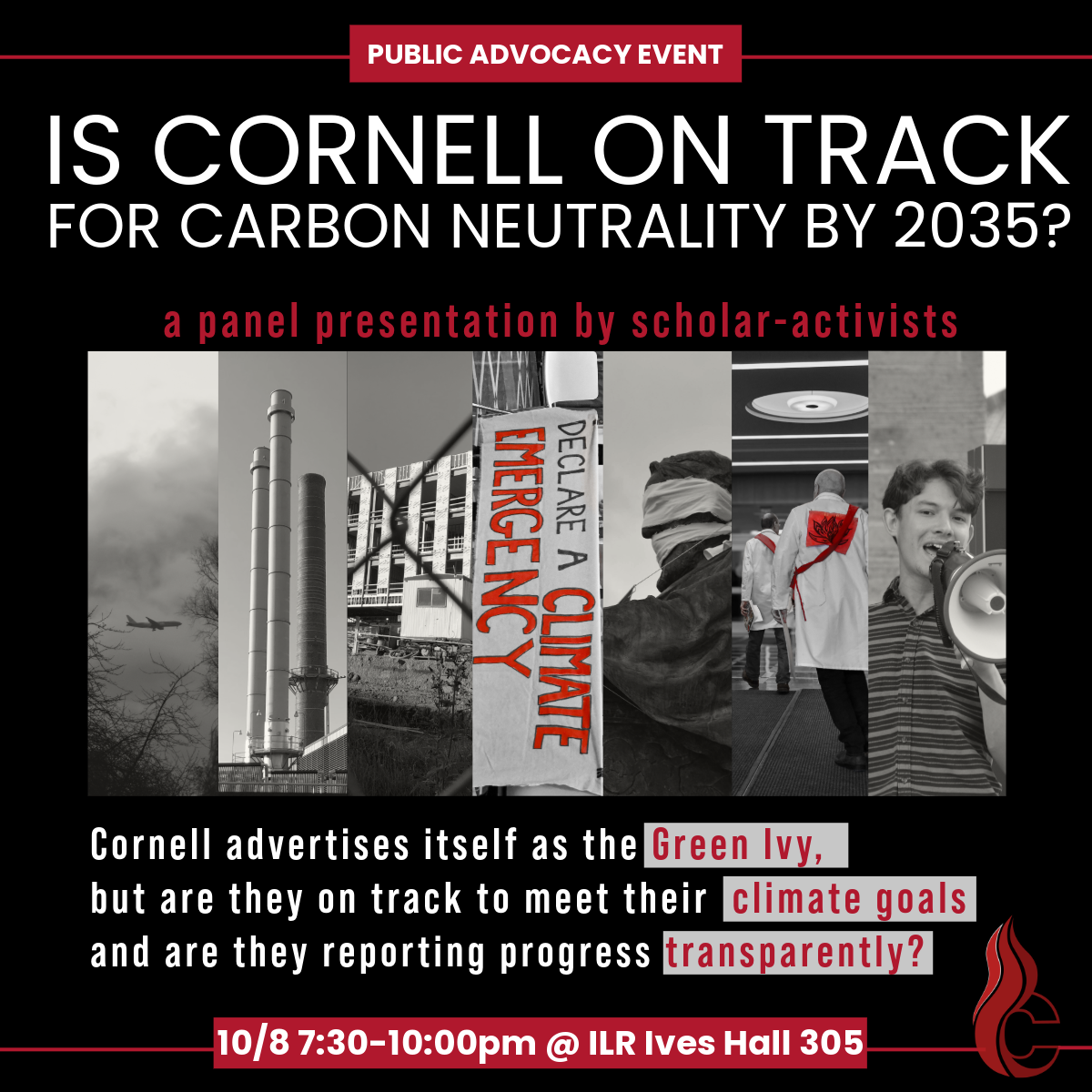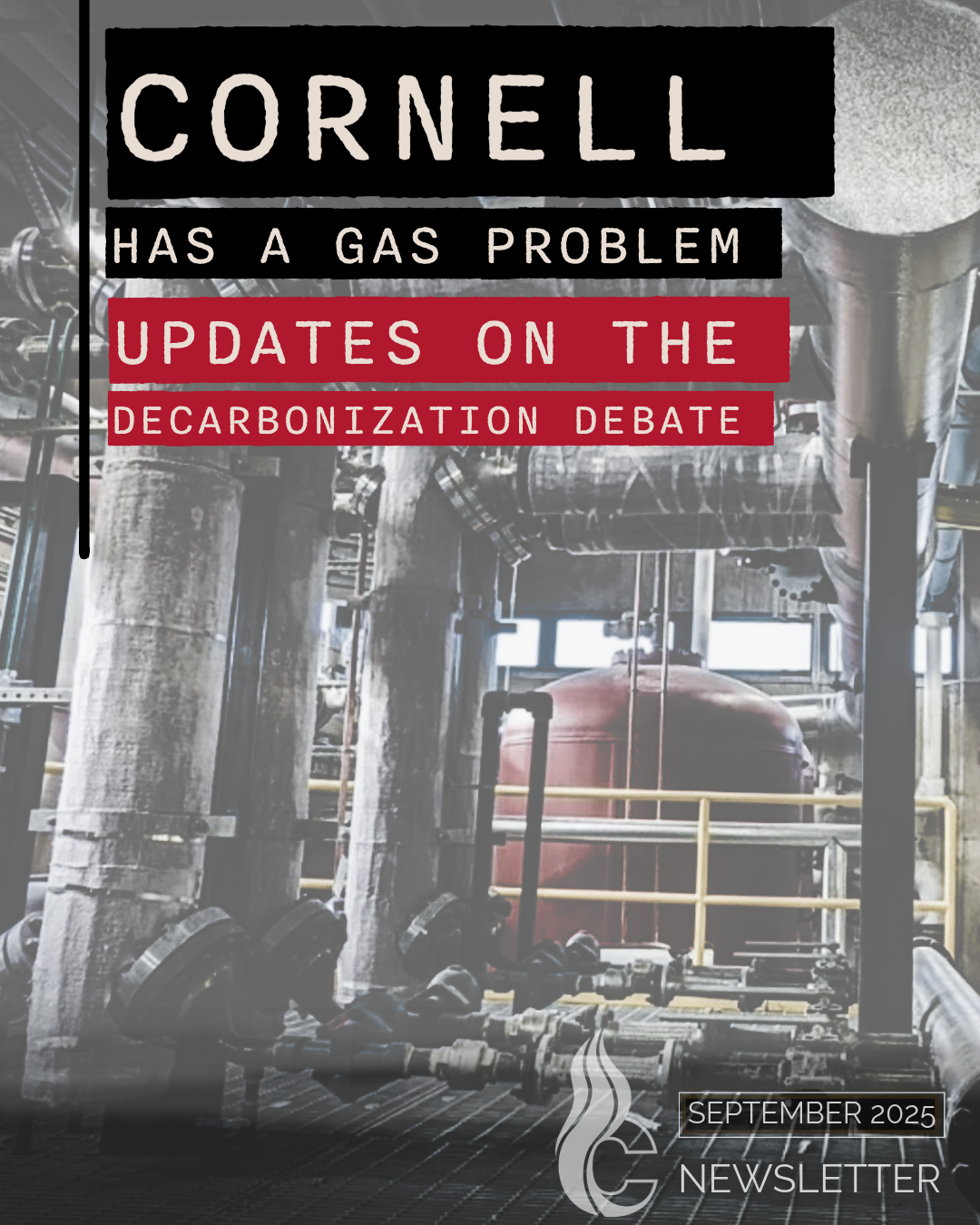Cornell has a gas problem
Updates on the decarbonization debate
Newsletter #21 published September 30, 2025
Dear Cornell on Fire,
As the days grow cooler, our minds turn again to the burning question of how to decarbonize our buildings’ heat. Here’s the scoop on what’s gone down since our Decarbonization Report provoked an op-ed from President Kotlikoff and a flurry of public presentations from the Cornell Energy Team.
The first thing you should know is that campus heat is NOT supplied by Cornell’s vaunted decarbonization project, Earth Source Heat (ESH). Not only is Cornell unsure whether or not ESH is feasible:* it has not yet secured funding for – let alone started – the next phase of research to establish the viability of the project that is their Plan A for decarbonization.
This question mark over Earth Source Heat is important because Cornell has missed a critical milestone in its own decarbonization plan. According to a 2016 report, the question of ESH feasibility should have been settled by now so that alternative solutions, if needed, could be pursued in time to meet Cornell’s carbon “neutrality” goal. Those alternative solutions are ground-source heat pumps – Cornell’s Plan B for decarbonization.* According to Cornell’s report, Plan B “would need to commence by 2025 if the University is to achieve neutrality by 2035.”
Yet today, in the waning days of 2025, campus heat is still supplied by a fracked-gas inferno at the Cornell power plant. Worse than that: instead of commencing with alternative solutions as promised, Cornell is doing precisely the opposite: they are lobbying the City and Town of Ithaca to exempt Cornell from the progressive Ithaca Energy Code Supplement (IECS) that requires new construction and renovations to phase out direct fossil fuel use by transitioning from gas to electric heat pumps beginning in 2026. Remarkably, the IECS requires that Cornell merely keep its promise: Start decarbonizing campus with heat pumps by 2026 if ESH has not yet proven feasible.
So why are Cornell administrators reneging on their own plan by lobbying for an exemption to Ithaca’s fossil-fuel phaseout? In presentations to decision makers and the public, Cornell administrators have claimed that compliance with the IECS would actually increase emissions. We agree that electrifying heat for buildings is only one essential step towards eliminating overall building sector emissions – it must work in parallel with grid decarbonization at the state level.* However, we disagree with Cornell’s claim that New York’s delayed progress on grid decarbonization obviates building electrification efforts “for the foreseeable future.” On the contrary, independent modeling finds that even in relatively pessimistic grid decarbonization scenarios, heat electrification is projected to yield significant emissions benefits.*
Unfortunately, Cornell has not made their analysis public, as might be expected of an institution asking for a change to a law. We do know that Cornell staff used short-run marginal emissions rates, which are known to overestimate emissions from electrification of heating, in their initial analysis used to lobby for an exemption. The same incorrect method is used by the American Gas Association to lobby against local electrification laws in the US.* It is very concerning that Cornell’s analysis (inadvertently or not) continues to grant legitimacy to Big Oil’s incorrect method even after we pointed this out to them. If Cornell uses this incorrect method as justification for changing Ithaca’s law, those lobbying to avoid electrification to protect their own financial interests may cite this as a source of legitimacy, despite ample peer-reviewed evidence that this method is inappropriate.
Truth be told, lobbying to avoid electrification serves Cornell’s own financial interests because their gas plant offers cheap energy. Cornell recently met with the Town and City to push again for their requested amendments to green building codes. Updates from the City are expected at the next Sustainability and Climate Justice Commission meeting. Meanwhile, Cornell administrators are reportedly in conversation with state-level decision makers and may attempt to get an exemption from the New York State building code’s fossil-fuel phaseout. While we are optimistic that Ithaca will hold the line on their Green Building Code, we must also keep our eye on these new state-level discussions (see upcoming events below). It is disappointing to see the effort and time invested by Cornell in circumventing decarbonization laws, that could instead be invested in advancing the university’s decarbonization.
We remain hopeful that Cornell will respond to the best available scientific evidence and comply with local and state laws mandating timely progress on decarbonization. And if Cornell is committed to making Earth Source Heat a reality instead of using it as a delay tactic to excuse lack of progress towards their climate goals, then they must fund it themselves or start following through aggressively with Plan B.*
Cornell won’t solve their gas problem without bottom-up pressure. Tell Cornell you support the fossil-fuel phaseout by signing our Decarbonization Petition – convincingly signed by all three authors of Ithaca’s building code. Get engaged at our public advocacy event reviewing Cornell’s climate action on 10/8, mingle at our Gallery Night this Friday, and join our monthly meeting on 10/25.
To a gas-free future,
Cornell on Fire
*Asterisks indicate where supplemental notes can be found by scrolling below. You can like this post and others on Instagram and Mastodon.





Take action with us!
October 16, 4pm at the Atkinson Center or on Zoom: NYSERDA President Doreen Harris speaks on state energy policy. While Cornell may be requesting an exemption from the NY State Building Code behind closed doors, you can encourage transparency by attending this talk to ask how NY State’s Building Code requires compliance by campus power plants. President Harris is also co-chair of the NY Energy Board and their new plan that backs way, way off from meeting the requirements of New York’s ambitious climate law. Please attend and ask her about all of this!
Upcoming CoF Events:
Film Screening of “The Plan” with CU Progressives: Tuesday 9/30, 7:30-9pm at Hollister Hall 306. A film screening of “The Plan That Came From the Bottom Up,” a film about a group of workers who developed alternatives to the military products their company made. With popcorn and discussion. Optional RSVP on the campus event page. Event organized by CU Progressives and supported by CoF.
Fridays on Fire Guerrilla Gardening: Friday 10/3, 12-2pm on Ho Plaza. Meet campus climate activists and spread seeds of action at our participatory protest this Friday. Drop by anytime between 12-2pm to watch, talk, and participate in the bottom-up greening of our world! With Cornell on Fire, Cornell YDSA Ecosocialists and Sunrise Cornell.
“Double Reality” Gallery Night: Friday, October 3rd, 5-8pm at 115 S Cayuga Street. Join us for a social event exploring the tensions of performing "normalcy" in climate breakdown.
Public advocacy event: Is Cornell on track for carbon neutrality by 2035? Wednesday 10/8, 7:30-10:00pm at ILR Ives Hall 305. This presentation by faculty, students, and activists will review evidence of Cornell’s climate progress to date and point to actionable steps forward. This event is open to the public.
Art-ivism Exhibit: Drop by the storefronts anytime at 115-121 South Cayuga Street (near the Commons) to engage with our provocative art exhibit to end climate silence, name climate criminals, and stop billionaires. Art installation will be available through 10/22.
Interested in joining our Working Group? We meet weekly on Tuesdays from 1-2pm and actively welcome new perspectives! Everyone can contribute to our campus-community coalition: students, staff, faculty, alumni, and community members. Fill out our interest form or reach out at connect@cornellonfire.org.
Join Cornell on Fire as a climate justice liaison. Our movement receives coalition requests from powerful movers and shakers on campus and beyond, such as the Rainforest Action Network, Campus Climate Network, and Scientist Rebellion Turtle Island. We need liaisons who can connect our work to theirs! This is a concrete way to support Cornell on Fire while driving the larger movement for climate justice. It’s easy: fill out our interest form to become a liaison who joins ally meetings and reports back to us.
Engage the Wider Movement:
Sign the Just Cause Employment petition. Things are finally moving forward in Ithaca for a Just Cause memo! Help the Just Cause Coalition fulfill their ambitious goal of collecting 2,000 petition signatures from workers in the City of Ithaca by the end of the year. Please sign the petition today and share with your friends, family, and colleagues. (Anyone in Ithaca is eligible to sign, even if they are not a worker.)
Sign the pledge to DUMP TIAA!: Cornell employees, did you know that Cornell funnels YOUR retirement funds into fossil fuels and Indigenous land grabs through TIAA? You can change this by taking the pledge to Dump TIAA. Tell TIAA (and Cornell): “If you still fund fossil fuels and agribusiness by by 2026, we will move our savings to a provider we can trust.”
Extinction Rebellion Climate Vigils 11am every Saturday at Chase Bank - the worst bank on Earth - at the East end of the Ithaca Commons.
In case you missed it. Catch up on our latest work:
Check out our latest communications:
Read the press coverage of our activities over the last month
Thank you for reading this far and engaging in the number-one frontline for climate action: your attention.
Supplemental Notes
*The Earth Source Heat Project. Cornell’s Plan A for heat decarbonization, Earth Source Heat (ESH) is an innovative technology that would harness geothermal heat from deep underground to warm campus. If successful, this groundbreaking (no pun intended) research project would be more efficient than heat pumps and could potentially be replicated in other locations. However, even if it proves viable, in the best case scenario ESH isn’t projected to serve the majority of campus until around 2035.
*Cornell’s Plan B for decarbonization: heat pumps. Heat pumps are actually part of Cornell’s Plan A as well: They will be needed to supplement Earth Source Heat even if it is successful because ESH will not serve all of campus (at best it will serve 95% of campus heat needs).
*On two parallel processes of decarbonization: Decarbonization of heating requires two things: 1) the transition from direct fossil fuel use (usually natural gas) to electricity use (a process known as electrification), and 2) decarbonization of grid electricity through switching the source of the electricity from fossil fuels to lower carbon sources such as solar and wind. Given the urgency of reducing our emissions, these two processes must happen in parallel rather than in sequence. Electrification of heating makes sense for reducing emissions in the long-term, even if some of the electricity will initially be provided by fossil fuels. This is due to the lifetime of heating equipment and the challenge of replacing it, as well as the fact that New York’s grid today is among the cleanest in the country and working to become even cleaner.
*Independent modeling efforts: Since the Cornell Energy Team did not make their modeling efforts public, a group of engineers and advocates including Cornell on Fire developed an independent model in a technical white paper. Their results diverged from those presented by the Cornell Energy Team, suggesting that, even in relatively pessimistic scenarios, electrification of heating for new construction was projected to yield significant emissions benefits. This model used a method known as long-run marginal emissions rates, which is the accepted method for heating electrification. Although long-run marginal emissions rates are difficult to predict because they depend on projections of future grid decarbonization, even pessimistic scenarios find benefits to electrification.
The Cornell Energy Team has critiqued the white paper by claiming they have more sophisticated models, but their reluctance to share their modeling efforts hinders attempts to better understand differences between the models. It is our understanding that most of the difference between the models is due to the Cornell Energy Team's incorrect use of short-run marginal emissions rates. Regardless, the fact remains that Cornell has not provided publicly available analysis using accepted methodology to support their claim that compliance with the IECS would increase emissions.
Nowhere have Cornell administrators explained why their own commitment to providing campus with 100% renewable electricity by 2035 should exclude electricity for heat pumps – in which case their argument that heat pumps will increase emissions becomes irrelevant (particularly if they commit to 24-7 renewable electricity procurement, as we argue Cornell should do in line with other climate-leading corporations).
*Cornell is using the same incorrect methodology as Big Oil to attack local building electrification laws. Both Cornell and Big Oil have leveraged short-run marginal emission rates to argue incorrectly that building electrification will increase emissions. While the American Gas Association continues to present misleading public-facing claims that gas heating saves emissions relative to heat pumps, they have quietly updated their narrative elsewhere. Between 2022 and 2023, the American Gas Association updated its attack on Denver’s decarbonization law to use long-run (instead of short-run) emission rates. That forced them to radically change their tune: They went from incorrectly arguing in 2022 that Denver’s law would scarcely reduce emissions, to correctly acknowledging in 2023 that it would reduce emissions by more than 50 percent. Now, Cornell is asking Ithaca to change its progressive energy code on the basis of an inaccurate methodology that even Big Oil has been forced to disavow. Read more in our Cornell Daily Sun op-ed in response to President Kotlikoff’s op-ed.
*The funding of Earth Source Heat. Unfortunately, Cornell is reluctant to put their own money towards the Earth Source Heat project, preferring instead to rely on external funders. Apparently, Cornell the Corporation considers it frivolous to spend $100-$250 million decarbonizing their campus in order to help keep the planet habitable, when they could spend money on things like giant houses for new plastic playing fields, new computer science buildings, and millions in pay raises for top administrators. Observers have raised a worthwhile question: Is Cornell only willing to take climate action so long as someone else pays for it?

